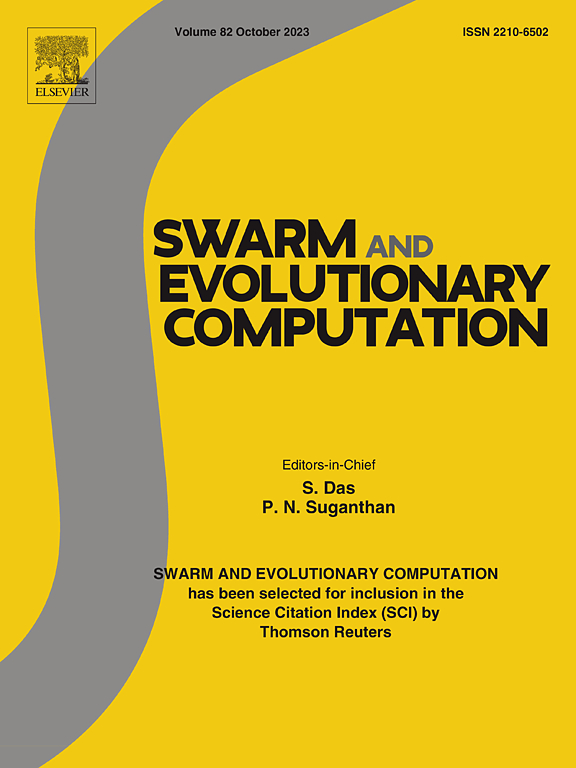Pareto multi-objective optimization for high locality-preserving space-filling curve identification
IF 8.2
1区 计算机科学
Q1 COMPUTER SCIENCE, ARTIFICIAL INTELLIGENCE
引用次数: 0
Abstract
Space-filling curves are widely used in applications that take advantage of the locality-preserving property. The pattern (the first order curve) plays a central role in locality preserving property. This was highlighted in previous works well-received by the community. A formulation was established leading to defined new patterns, including competitive patterns, i.e., patterns carrying comparable (and sometimes better) locality-preserving level than the Hilbert curve, so far the reference. Nevertheless, the number of pattern solutions resulting from the given formulation exponentially grows up with the space dimension.
In this article, with the help of an evolutionary algorithm, an original approach dedicated to the identification of high locality-preserving multidimensional patterns is proposed. Our idea is to embed the problem in a multi-objective optimization framework guided by Pareto optimality. In a such framework, each locality score (through a standard criteria) obtained by a pattern at a specific radius value can be processed as an objective function (to be minimized). The overall multi-objective function then illustrates how well the objectives are met, i.e. how the locality is achieved as progressively the space is filled. So, several space radii of interest are taken into account in the locality estimation and not a single one. This track contributes to define an accurately process of pattern identification.
Comparative experimental results led on dimensions upper than three, seem to confirm that the proposed approach is Reliable, Efficient and Flexible. The results showed that the classical RBG pattern is not Pareto optimal in the 5-D case and alternative patterns are emerging. Finally, being able to identify patterns that preserve locality at a competitive level compare to the referent Hilbert curve (RBG pattern-based) constitutes a real contribution and could greatly improve the effectiveness of applications.
空间填充曲线被广泛应用于利用位置保持特性的应用中。图案(一阶曲线)在位置保持特性中起着核心作用。这一点在之前的工作中得到了强调,并受到了社区的广泛欢迎。我们提出了一种新的模式,其中包括竞争模式,即与希尔伯特曲线(迄今为止的参考曲线)相比,具有类似(有时甚至更好)的位置保持水平的模式。然而,随着空间维度的增加,由给定公式得出的模式解的数量也呈指数增长。本文借助进化算法,提出了一种专门用于识别高位置保持多维模式的原创方法。我们的想法是将问题嵌入以帕累托最优性为指导的多目标优化框架中。在这种框架中,图案在特定半径值上获得的每个局部性得分(通过标准标准)都可以作为目标函数(最小化)来处理。然后,整体多目标函数就能说明目标的实现情况,即随着空间逐渐被填满,局部性是如何实现的。因此,在定位估算中,需要考虑多个感兴趣的空间半径,而不是单一的空间半径。在三维以上维度上的对比实验结果似乎证实了所提出的方法是可靠、高效和灵活的。结果表明,经典的 RBG 模式在 5 维情况下并非帕累托最优模式,替代模式正在出现。最后,与参考希尔伯特曲线(基于 RBG 模式)相比,能够识别在竞争水平上保持局部性的模式是一个真正的贡献,可以大大提高应用的有效性。
本文章由计算机程序翻译,如有差异,请以英文原文为准。
求助全文
约1分钟内获得全文
求助全文
来源期刊

Swarm and Evolutionary Computation
COMPUTER SCIENCE, ARTIFICIAL INTELLIGENCEC-COMPUTER SCIENCE, THEORY & METHODS
CiteScore
16.00
自引率
12.00%
发文量
169
期刊介绍:
Swarm and Evolutionary Computation is a pioneering peer-reviewed journal focused on the latest research and advancements in nature-inspired intelligent computation using swarm and evolutionary algorithms. It covers theoretical, experimental, and practical aspects of these paradigms and their hybrids, promoting interdisciplinary research. The journal prioritizes the publication of high-quality, original articles that push the boundaries of evolutionary computation and swarm intelligence. Additionally, it welcomes survey papers on current topics and novel applications. Topics of interest include but are not limited to: Genetic Algorithms, and Genetic Programming, Evolution Strategies, and Evolutionary Programming, Differential Evolution, Artificial Immune Systems, Particle Swarms, Ant Colony, Bacterial Foraging, Artificial Bees, Fireflies Algorithm, Harmony Search, Artificial Life, Digital Organisms, Estimation of Distribution Algorithms, Stochastic Diffusion Search, Quantum Computing, Nano Computing, Membrane Computing, Human-centric Computing, Hybridization of Algorithms, Memetic Computing, Autonomic Computing, Self-organizing systems, Combinatorial, Discrete, Binary, Constrained, Multi-objective, Multi-modal, Dynamic, and Large-scale Optimization.
 求助内容:
求助内容: 应助结果提醒方式:
应助结果提醒方式:


